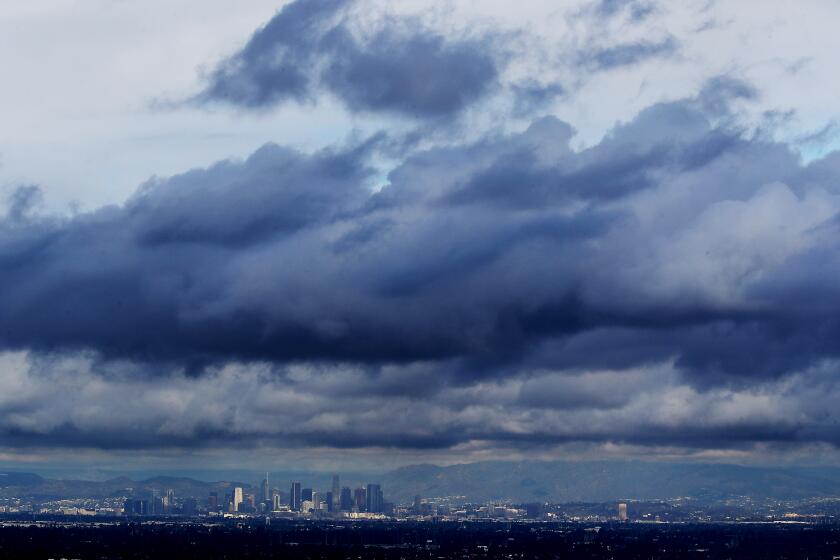Region braces for rain as storms threaten to unleash fire debris; PCH reopens

- Share via
Back-to-back atmospheric rivers are expected to hit Southern California this week, raising hopes of a definitive end to a catastrophic fire season, while also heightening concerns about debris flows in the region’s burn scar areas.
The first atmospheric river is set to peak in Los Angeles and Ventura counties Tuesday night and last through midday Wednesday, with the second storm forecast to hit Thursday night and last into Friday morning.
Both storms are expected to drop light-to-moderate rain, falling at a rate that should produce only minor impacts. There is a less than 5% chance of rain falling at a rate so intense that it could trigger significant mud and debris flows in Los Angeles and Ventura counties, said Todd Hall, a meteorologist with the National Weather Service in Oxnard.
Still, officials have warned residents whose neighborhoods were devastated by the Palisades and Eaton fires last month to remain on alert. Some of the heaviest rain in Los Angeles County is expected to fall during Wednesday’s early morning hours and late Thursday into Friday morning, Hall said.
“We’re gonna have to see how this evolves. The second storm could bring maybe a little higher potential [for mud and debris flows] for Eaton and Palisades, but we’re going to keep monitoring that as we move through this week,” Hall said.
Another rain event is heading to fire-weary Los Angeles next week. Meanwhile, Northern California is in for an atmospheric river.
Rainfall has the potential to be particularly focused on south-facing mountain slopes and hillsides, because of the path of the moisture arriving in the region, Hall said. This is a concern because a number of fire burn areas — including the Palisades and Eaton fire zones — are on south-facing slopes.
In the first storm, peak rainfall rates are anticipated to be light — between one-tenth of an inch per hour to one-quarter of an inch per hour in Los Angeles County. And in Ventura, Santa Barbara and San Luis Obispo counties, peak rain rates could be moderate — between one-quarter of an inch per hour to one-half of an inch per hour, although there could be isolated locations of up to three-quarters of an inch per hour.
There is a 10% to 20% chance that rainfall rates could get up to two-thirds of an inch per hour over the 38,664-acre Lake fire, which burned last summer in the mountains southeast of Santa Maria and north of Los Olivos in Santa Barbara County. The key threshold for rainfall rates that can trigger significant debris flow is at least a half-inch per hour.
Rain totals are not yet clear for the second storm, with forecasters anticipating a range of a quarter of an inch to an inch of precipitation across the region.
In Los Angeles County, public works crews rushed to create additional capacity in debris basins to capture mud and other materials that might flow down from the burn scars during the storms.
L.A. County Public Works Director Mark Pestrella estimated that the Palisades and Eaton fires generated about 10 billion pounds of debris consisting of trash, material from homes, charred vegetation and sediment from denuded hillsides.
“We’re taking immediate steps to stop fire debris from washing on the beaches and into the storm drain system and potentially destroying homes,” he said during a Sunday news conference.
The California Office of Emergency Services set up 679 feet of K-rail concrete barriers and 1,500 sandbags along Cloudcroft Drive in Malibu and similar efforts were underway at other locations within the Palisades and Eaton burn areas. Officials have also installed compost filter socks, a type of berm, and other items around burned homes to filter debris and prevent it from flowing into storm drains, Pestrella said.
Meteorologists are hopeful that the ongoing storms will help bring a decisive end to one of Southern California’s most destructive fire seasons. Generally, the region needs 2 to 4 inches of widespread rainfall for the fire season to end. Downtown Los Angeles has received just over half of an inch of rain since January, according to the weather service.
The persistent lack of rain has dried out vegetation to the point where it’s extremely flammable.
“We’re hopeful that after these two storms that might be enough” to end the fire season, Hall said. “But we’re still seeing that ... the fuel still could be susceptible, because it takes awhile for the rainfall to soak in the soil and get into the native vegetation.”
It can typically take three to six weeks for vegetation like chaparral and coastal sage to soak up moisture from rainfall, Hall said.
Meteorologist Alex Tardy of the weather service’s San Diego office said data indicate that vegetation has absorbed plenty of moisture from the rain the region has received so far.
“So we’re up around average right now,” Tardy said. “We were flirting with record lows when … we had our Santa Ana wind and red flag warning.”
“As long as it stays cool, and we don’t have additional Santa Ana winds and get a little bit of precipitation like we’re going to see this week — that buys us time in February,” Tardy said. “A little bit of rain and snow goes a long way in the middle of the winter.”
But another moderate Santa Ana wind event could be on the horizon over the weekend. And despite the recent rain, much of Southern California is still dry, having received less than 25% of average rainfall at this point in the season.
Meanwhile, Pacific Coast Highway opened for the first time in weeks early Monday as Pacific Palisades residents continued to grapple with officials over the possibility of lifting restrictions on access to fire-ravaged neighborhoods.
PCH, which had been swept by flames and beset by debris flows, was opened between the McClure Tunnel in Santa Monica and Carbon Beach Terrace in Malibu. However, just one lane in each direction was opened, with a speed limit of 25 mph. There is no parking along the highway as repair work in the area continues, officials said.
The scenic stretch of highway had been closed since Jan. 7, when firefighters first began battling the Palisades fire. Ultimately, 23,400 acres burned and 6,800 structures — many of them homes — were destroyed. Parts of the highway reopened in Malibu on Sunday, but plans to remove all checkpoints for access to the Palisades were delayed.
The reopening of the Palisades and subsequent reversal over the weekend were marred by a striking lack of government coordination, both within the city of Los Angeles and between the city and the county.
Bass first told residents during a webinar Friday afternoon that she planned to reopen the neighborhood to the public. The announcement incited rage among those tuning in and brought a sharp critique from Councilmember Traci Park, who said publicly that she disagreed with the move.
City recovery czar Steve Soboroff, who was appointed by Bass, was also unaware of the mayor’s decision to reopen the neighborhood to the public until a reporter informed him of the news shortly after the community meeting ended. Soboroff said he thought the move was premature.
Pacific Palisades residents have voiced concerns about members of the general public having access to the fire zone, citing issues including toxic pollution, public safety and crime.
Nearly 5,000 people signed a change.org petition after the Friday meeting to urge officials to maintain restricted access for devastated neighborhoods, saying that reopening too early would offer “no tangible benefit to residents and would only place an unnecessary burden on a community that has not even begun to recover.”
When Bass reversed her decision Saturday night — hours before the neighborhood was set to reopen to the public — her office did not inform County Supervisor Lindsey Horvath, who also represents the area. The city’s reversal also delayed the reopening of a swath of Pacific Coast Highway by a day, sowing more confusion since the county still proceeded with its plan to reopen other sections of the highway.
Access to Palisades neighborhoods remains restricted to residents and authorized contractors who have passes, Bass’ office said Monday. Residents and contractors can obtain passes at the parking structure of the Disaster Recovery Center at 10850 Pico Blvd. in Westwood. Passes are available daily from 10 a.m. to 5 p.m.
The beachside thoroughfare reopened in Malibu up to Coastline Drive on the north end Sunday, but remained closed between Coastline Drive and Entrada Drive.
Horvath released a statement late Saturday calling the city’s decision a “surprise.” When reached by The Times on Sunday, a public information officer for the Los Angeles Fire Department, a city agency, said she learned about Bass’ reversal through a press release.
The California Highway Patrol and National Guard have taken over controlling access to the Palisades, according to the mayor’s office.
“We continue to adapt in real time to this dynamic situation,” read a prepared statement issued by the mayor’s office Saturday. “This plan secures the Palisades and eases the strain on LAPD, whose ability to respond across L.A. has been impacted for nearly one month. My priority continues to be rebuilding the Palisades as rapidly and safely as possible.”
For the first time since the devastating Palisades fire ignited on Jan. 7, all Pacific Palisades residents can now return to their properties.
The confusion over reopening Pacific Coast Highway caused some tension on the Westside of Los Angeles.
Malibu Mayor Doug Stewart urged the city of Los Angeles in a statement on Sunday to “work collaboratively with all affected jurisdictions in the future to ensure clarity, consistency, and thoughtful communication.”
“Our communities have a hard enough road ahead — these moments require coordination and leadership, not confusion.”
Times staff writers Sonja Sharp, Clara Harter and Dakota Smith contributed to this report.
More to Read
Sign up for Essential California
The most important California stories and recommendations in your inbox every morning.
You may occasionally receive promotional content from the Los Angeles Times.














